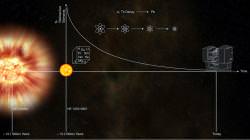The Universe is thought to be 13.7 billion years old. So it was quite a surprise when astronomers turned up a star that’s 13.2 billion years old. That means it formed only a few hundred million years after the Big Bang.
The star, HE 1523-0901, was discovered by the European Southern Observatory’s VLT. Astronomers knew right away that that had an old star, but the technique for dating it accurately is pretty difficult. The method is similar to radiocarbon dating, where archaeologists use the approximate quantities of carbon isotopes to measure the age of ancient artifacts.
In this situation, though, the astronomers used the VLT to measure the abundance of the various radioactive elements, like thorium and uranium. Once the star originally formed, its radioactive elements began to decay, changing into other elements. By knowing the rate of decay, and being able to measure these elements so accurately, they were able to peg the ages of the star at 13.2 billion years old. The trick was to find elements that decay at a set rate, but would still be around after billions of years of decay.
Original Source: ESO News Release


Why not place the universe at more the 80 trillion?
Earth alone could be, …….say 600 billion?
Is there some other way to measure the universe?
12-19 billion really seems way to short.
i dont realy get why they use the word ‘years’ it realy confuses me n even in the picture there is ‘today’